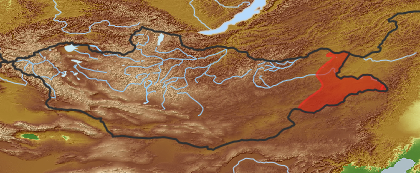| Class: | angiosperms |
| Order: | Malpighiales |
| Family: | Euphorbiaceae |
| Genus: | Euphorbia |
| Scientific name: | Euphorbia mandshurica Maxim. |
| Name acc. to: | Gubanov 1996 |
| Herbar: | list records  |
| open map in a new window |  |
| Habitat: | Forb-grass sandy steppes (Grubov 2001) |
| Habit (i)general appearance of a plant | |
| Growth form: (i)Herb, shrub, tree or climber. | herb (i)Herbaceous, erect plant, up to 2m high, mostly with a leafy shoot; if perennial, shoots die to the ground each season, shoots are not woody
example: Artemisia pectinata   inherited by genus Euphorbia: herb inherited by genus Euphorbia: herb
|
| Smell & Touch: (i)General appearance of the plant. | abundant milky juice (latex) (i)Shoots and often leaves contain white or yellowish latex
example: Asclepiadaceae, Euphorbiaceae, Lactuca tatarica  inherited by genus Euphorbia: abundant milky juice (latex) inherited by genus Euphorbia: abundant milky juice (latex)
|
| Parasite status: (i)Is the plant a half- or full parasite? | no parasite/saprophyte (i)Plant fully autonomous, leaves with chlorophyll
example: Most plants, Ranunculus  inherited by family Euphorbiaceae: no parasite/saprophyte inherited by family Euphorbiaceae: no parasite/saprophyte
|
| Water or terrestrial plant: (i)Where do the plants grow? | terrestrial (i)Plant grows on dry land
example: Orostachys spinosa  inherited by family Euphorbiaceae: terrestrial inherited by family Euphorbiaceae: terrestrial
|
| Leaf (i)expanded, usually photosynthetic organ of a plant (including phylloclades) | |
| Leaf development: (i)Structure and development of leaves. | with green leaves (i)Plant with green leaves  inherited by family Euphorbiaceae: with green leaves inherited by family Euphorbiaceae: with green leaves
|
| Leaf arrangement: (i)Arrangement of leaves at the stem. | opposite, opposite-decussate (i)Two leaves per node
example: Lamiaceae, e.g. Phlomis    inherited by family Euphorbiaceae: opposite, opposite-decussate inherited by family Euphorbiaceae: opposite, opposite-decussate
alternate (i)One leaf per node; distiche: arranged in two vertical rows, equitant
example: Phragmites    inherited by family Euphorbiaceae: alternate inherited by family Euphorbiaceae: alternate
|
| Simple or divided leaves: (i)Are the leaves simple or completely divided in several parts? Blade of the leaf entire or (more or less) deeply dissected. Attention: There are various appearances of the leaf margin (from entire to toothed and lobed). Here, we ignore this and ask only for dissections that separate the leaf for more than one third of its length or width, whatever is smaller. Sometimes, it is difficult to tell apart compound leaves from a shoot system with simple leaves: look for stipulae and/or axillary buds at the ground of the leaves: if only some possess these structures, the others are most likely leaflets of a compound leaf. | simple (i)Non-divided leaf, but margin may be incised nearly to the ground   inherited by family Euphorbiaceae: simple inherited by family Euphorbiaceae: simple
|
| Leaf margin: (i)Structure of leaf margin (or that of a leaflet in case of compound leaves). Attention: Here we ask for the leaf margin, defined as all those dissections that separate the leaf for less than one third of its length or width, whatever is smaller. To be worked out: how to handle margin of pinnate leaves? | entire (i)Plain margin, not toothed
example: Iris   inherited by family Euphorbiaceae: entire inherited by family Euphorbiaceae: entire  inherited by genus Euphorbia: entire inherited by genus Euphorbia: entire
|
| Stipule: (i)Leaflets at the base of the petiole, these are smaller and of different shape. | none (i)Without stipules
example: Euphorbia, Ericaceae s.l.  inherited by genus Euphorbia: none inherited by genus Euphorbia: none
|
| Leaf colour upper side: (i)Shades of green on the leaf, upper side. | green (i)Clear green
example: Tribulus terrestris  inherited by family Euphorbiaceae: green inherited by family Euphorbiaceae: green
|
| Leaf colour lower side: (i)Shades of green on the leaf, lower side. | green (i)Clear green, in most species
example: Angelica decurrens  inherited by family Euphorbiaceae: green inherited by family Euphorbiaceae: green
|
| Leaf veination: (i)Arrangement of the main veins of a leaf. | pinnate (i)One main vein, several side veins, sometimes inconspicuous
example: Cicerbita     inherited by family Euphorbiaceae: pinnate inherited by family Euphorbiaceae: pinnate
|
| Flower (i)reproductive portion of the plant, consisting of sepals, petals, stamens, and pistils | |
| Flower appearance and pollination: (i)General appearance of the flower. | not attractive, wind-pollinated or some water plants (i)Small, colourless or green flowers
example: Betula, grasslike plants: Carex, Setaria, Juncus  inherited by family Euphorbiaceae: not attractive, wind-pollinated or some water plants inherited by family Euphorbiaceae: not attractive, wind-pollinated or some water plants
|
| Flower colour: (i)Attention: assess colour of the most colourful parts of the flower, but not of the stamens; be aware of single plants with a mutation (mostly white) on flower colour. | greenish (i)petals absent or not distinctly different from colours of leaves, only stigmas (white) or anthers (yellow) may differ in color
example: Chenopodium, Triglochin  inherited by family Euphorbiaceae: greenish inherited by family Euphorbiaceae: greenish
yellow to orange (i)Pale to golden yellow
example: Ranunculus, Crepis  inherited by family Euphorbiaceae: yellow to orange inherited by family Euphorbiaceae: yellow to orange
|
| Perianth arrangement: (i)Attention: in some plants, flowers may be dimorphic in different ways (dioecious or gynodioecious). If flowers vary, record the characters of the most showy flowers. | absent or strongly reduced (i)No perianth leaves ensheathing stamen and/or carpels
example: Callitriche   inherited by family Euphorbiaceae: absent or strongly reduced inherited by family Euphorbiaceae: absent or strongly reduced  inherited by genus Euphorbia: absent or strongly reduced inherited by genus Euphorbia: absent or strongly reduced
|
| Sepal number: (i)Number of sepal leaves (outer perianth leaves, calyx leaves, mostly greenish). Attention, this character applies only for flowers separated in sepals and petals, thus excluding most monocots. Be aware of the bracts (involucral leaves) of Asteraceae flowerheads, do not qualify these as sepals! Be also aware in Rosaceae is often an epicalyx developed, in this case count all parts. | none or rudimentary (i)Hardly visible or absent, since perianth uniform
example: All monocots with uniform perianth, many Asteraceae and Apiaceae  inherited by genus Euphorbia: none or rudimentary inherited by genus Euphorbia: none or rudimentary
|
| Petal / Tepal number: (i)Number of petal leaves (inner perianth leaves, usually coloured). | none or reduced (i)But green sepals may exist
example: Thalictrum  inherited by family Euphorbiaceae: none or reduced inherited by family Euphorbiaceae: none or reduced  inherited by genus Euphorbia: none or reduced inherited by genus Euphorbia: none or reduced
|
| Spur: (i)A hollow, slender, sac-like appendage of the perianth leaves, storing nectar. | no spur (i)Flower without appendage
example: Peganum  inherited by family Euphorbiaceae: no spur inherited by family Euphorbiaceae: no spur
|
| Stamen number: (i)Attention: We ask for the reproductive organs of the flower dispersing pollen. Count only fully fertile stamens, not staminodia (e.g. Parnassia). | 1 (i)
example: Orchis  inherited by genus Euphorbia: 1 inherited by genus Euphorbia: 1
|
| Pistil number: (i)Number of pistils (female floral organs: style, if developed; stigma and carpels/ovary together build the pistil). | 3 (i)Three stigmas, usually in a triangle
example: Stellaria, Euphorbia, Campanula, Allium  inherited by family Euphorbiaceae: 3 inherited by family Euphorbiaceae: 3
|
| Carpel fusion: (i)To which degree are the carpels (modified leaf forming simple pistil or part of a compound pistil) fused. | fused (i)Carpels united into an ovary, only styles are free
example: Malus, Berberis  inherited by family Euphorbiaceae: fused inherited by family Euphorbiaceae: fused
|
| Style number: (i)Portion of the pistil connecting the stigma to the ovary. | 3  inherited by family Euphorbiaceae: 3 inherited by family Euphorbiaceae: 3
|
| Ovary position: (i)For entirely or partly fused carpels, describe their position in relation to the insertion point of perianth leaves (best done by doing a longitudinal section of a flower). | superior (hypogynous) (i)Base of carpels attached above insertion point of perianth leaves, carpels free or fused
example: Delphinium, Anemone    inherited by family Euphorbiaceae: superior (hypogynous) inherited by family Euphorbiaceae: superior (hypogynous)
|
| Sex: (i)Distribution of male and female organs among flowers, only most commonly cases. | unisexual (i)
example: Rhodiola  inherited by family Euphorbiaceae: unisexual inherited by family Euphorbiaceae: unisexual  inherited by genus Euphorbia: unisexual inherited by genus Euphorbia: unisexual
monoecious (i)Male and female flowers at the same plant
example: Xanthium, Larix, Atriplex  inherited by genus Euphorbia: monoecious inherited by genus Euphorbia: monoecious
|
| Inflorescence (i)flowering part of a plant, describes the arrangement of the flowers on the flowering axis | |
| Inflorescence: (i)Structure of the inflorescence. | Flowers in inflorescence (i)No solitary flowers  inherited by genus Euphorbia: Flowers in inflorescence inherited by genus Euphorbia: Flowers in inflorescence
Compound inflorescences (i)Flowers on shoots of higher orders (complex branched)
example: Solidago   inherited by genus Euphorbia: Compound inflorescences inherited by genus Euphorbia: Compound inflorescences
|
| Fruit (i)the seed bearing organ, with or without adnate parts; a ripened ovary and any other structures which are attached and ripen with it. Aggregate fruits are handled like simple fruits for determination. | |
| Consistency: (i)Fleshy fruits or dry fruits, see dispersal adaptations for further classification. | dry (i)With a dry outer shell, no fleshy parts, but seed (embryo) could be edible  inherited by family Euphorbiaceae: dry inherited by family Euphorbiaceae: dry
|
| Type of fruit: (i)Common fruit types (including pseudocarp). | Solitary fruits (i)     inherited by family Euphorbiaceae: Solitary fruits inherited by family Euphorbiaceae: Solitary fruits
capsule (i)Dry dehiscent fruit, releasing seeds by slits or holes.
example: Poppy, most Caryophyllaceae, Cerastium, a lot of Scrophulariaceae, Iris (oppened capsule looks like Delphinium), Zygophyllum - it is a very common fruit type     inherited by family Euphorbiaceae: capsule inherited by family Euphorbiaceae: capsule
Dehiscent fruits (i)Fruits open along a longitudinale line (except silicula)  inherited by family Euphorbiaceae: Dehiscent fruits inherited by family Euphorbiaceae: Dehiscent fruits
|
| Opening of fruit: (i)Mode of dehiscence at maturity to release seeds. | opening along dehiscent line (i)Opening along a preformed line
example: Vicia, Lathyrus: pods  inherited by family Euphorbiaceae: opening along dehiscent line inherited by family Euphorbiaceae: opening along dehiscent line
opening / dehiscent (i)Dry? Fruits opening with different types  inherited by family Euphorbiaceae: opening / dehiscent inherited by family Euphorbiaceae: opening / dehiscent
|
| Root / shoot below ground (i)plant part below ground (in most cases), including below ground shoots, without leaves | |
| Root type: (i)Organisation of the roots. | allorhizous (i)Plant with a conspicuous tap root, one larger tap root with side roots
example: Dicotyledonae  inherited by order Malpighiales: allorhizous inherited by order Malpighiales: allorhizous
roots unequal in diam. (allorhizous) (i)Plant with many roots, but these differ in size and grow scattered along a root stock or a rhizome
example: Euphorbia  inherited by genus Euphorbia: roots unequal in diam. (allorhizous) inherited by genus Euphorbia: roots unequal in diam. (allorhizous)
|
| Distribution (i)region where the plant is likely to be found | |
| Distribution (Veg. Zones): (i)acc. to Grubov 1952 | Great Khingan (i)In distribution data often named as '5' 
East Mongolia (i)In distribution data often named as '9' 
acc. to: Gubanov 1996 |